Side Selection Importance: Winning Edge in Esports & League of Legends
Updated On: October 26, 2025 by Aaron Connolly
Defining Side Selection and Its Significance
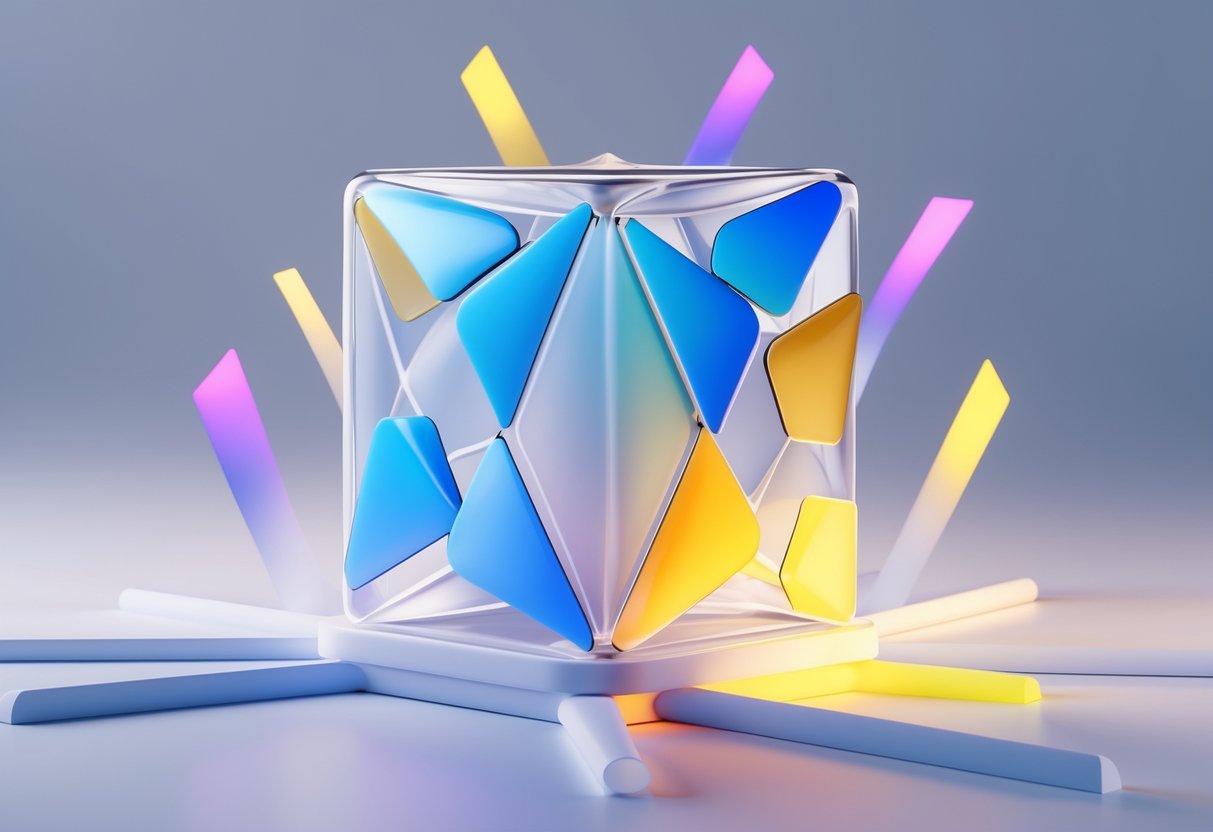
Side selection decides whether a team plays from the blue or red position on the map. This choice shapes strategies and can swing match outcomes by a few percentage points.
It affects draft phases, which champions teams get, and even how they control objectives or territory. That’s a lot riding on a single decision.
Core Role in League of Legends
In League of Legends, side selection gives each team unique advantages. Blue side gets the first pick in the champion draft, so teams can grab the most powerful champions right away.
Red side teams usually have to ban those overpowered champions, especially at big tournaments. You’ll see red side banning OP champs over 80% of the time.
Red side makes up for this with the last pick. They can counter-pick specific lanes, which helps them target star players or shut down tough matchups.
Map positioning also changes things. Blue side controls the top half better, while red side tends to own the bottom. These patterns affect which objectives each side secures.
Blue side usually grabs more Heralds. Red side, with better pit access, often picks up more early Dragons. Pro teams adjust their playstyles around these baked-in advantages.
Impact on Competitive Integrity
Side selection really does impact pro matches. Stats from major leagues show blue side wins around 52% of games.
In the first games of tournaments, the blue side advantage jumps to nearly 53%, since teams can’t adapt between games.
But in best-of-series formats, red side actually starts winning a bit more after game one. Teams figure each other out and change their bans and picks.
Coin flips decide initial side selection in big tournaments. That randomness frustrates some pros who feel it messes with competitive integrity.
The debate got heated when T1’s coach blamed their 2022 MSI Finals loss on bad side selection. Some critics said that was just an excuse, shifting focus away from gameplay.
Game balance updates have helped. The blue side edge dropped to about 51% in 2022, so the gap’s not as big as it used to be.
Influence Across Esports Titles
Side selection isn’t just a League thing. Valorant splits teams into attackers and defenders, which calls for different tactics.
Counter-Strike does something similar. Teams play as terrorists or counter-terrorists, then swap sides to keep things fair.
MOBA games like Dota 2 use the same kind of draft order and map positioning. The strategic layer feels pretty familiar if you’ve played League.
Fighting games take a different approach, using stage selection or character counterpicks. The idea’s the same, but the mechanics are unique.
Some esports titles skip side advantages altogether. Rocket League, for example, uses symmetrical arenas so everyone starts on equal footing.
Most top esports keep some version of side or draft advantage. It adds depth and keeps things interesting for fans and players.
How Side Selection Works in Professional Matches
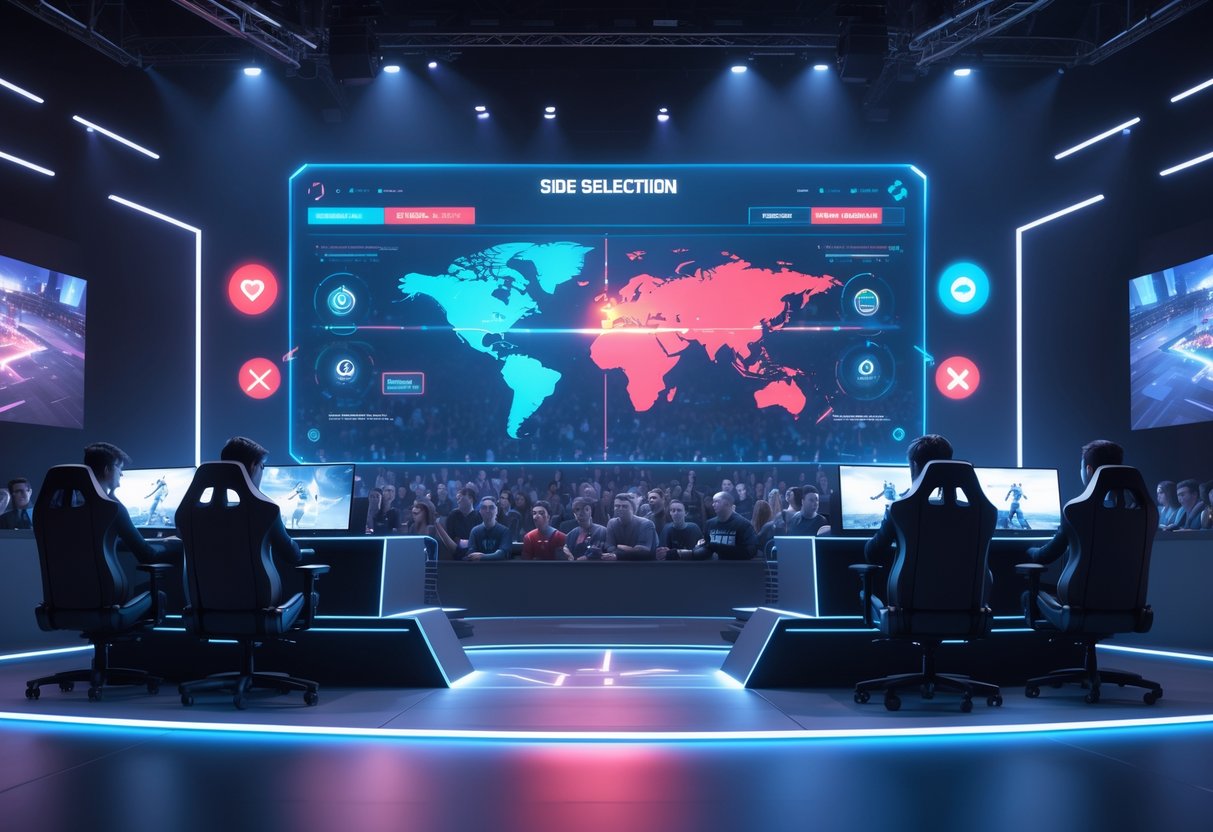
Pro matches use set rules to decide who picks their side. Usually, the higher-seeded team gets first dibs in tournaments.
In regular season games, leagues often rotate side selection between teams.
Procedures for Side Assignment
Regular season matches go by simple rules. Each team typically gets to pick their side once when they face off twice in a split.
The “home team” picks first in Game 1. They choose either red or blue, depending on what fits their plan.
Tournament matches shake things up. The higher seed gets side selection priority for the first game, giving them a strategic advantage in elimination rounds.
Blue side gets first champion pick in the draft. Red side gets the last pick, so they can counter whatever blue side does.
Some leagues, like the PCS and VCS, use 1v1 showdowns to decide who gets to pick sides.
Deciding Sides in Finals and Series
In best-of-five series, the higher seed picks the side for Game 1. After that, the losing team chooses sides for the next game.
The pattern goes like this:
- Game 1: Higher seed chooses
- Games 2-4: Loser of previous game chooses
- Game 5: Depends on the tournament
The LPL does something different for Game 5. Teams send a player for a solo match to decide who picks the final side.
Best-of-three series work similarly. Game 1’s loser picks for Game 2. If there’s a Game 3, the loser of Game 2 picks.
This system keeps things fair, so no team hogs the side advantage through a whole series.
Tournament-Specific Regulations
LCK and LPL stick to international rules for most matches. Higher seeds get Game 1 side selection, then the losing team picks for the rest.
Regional tournaments sometimes have their own quirks. Some let teams negotiate side selection based on the schedule.
At international events like Worlds, organizers use strict seeding rules. Pool play matches often come with set side assignments for fairness.
The VCS uses 1v1 showdowns for Game 3 in best-of-threes. That adds a fun twist to the series.
Finals matches usually give the upper bracket or higher seed team the first side selection. It’s a reward for performing better during the tournament.
A few tournaments still use coin flips or random assignment for some matches. But most leagues prefer to tie side selection to skill or performance.
Blue Side Versus Red Side: Key Differences
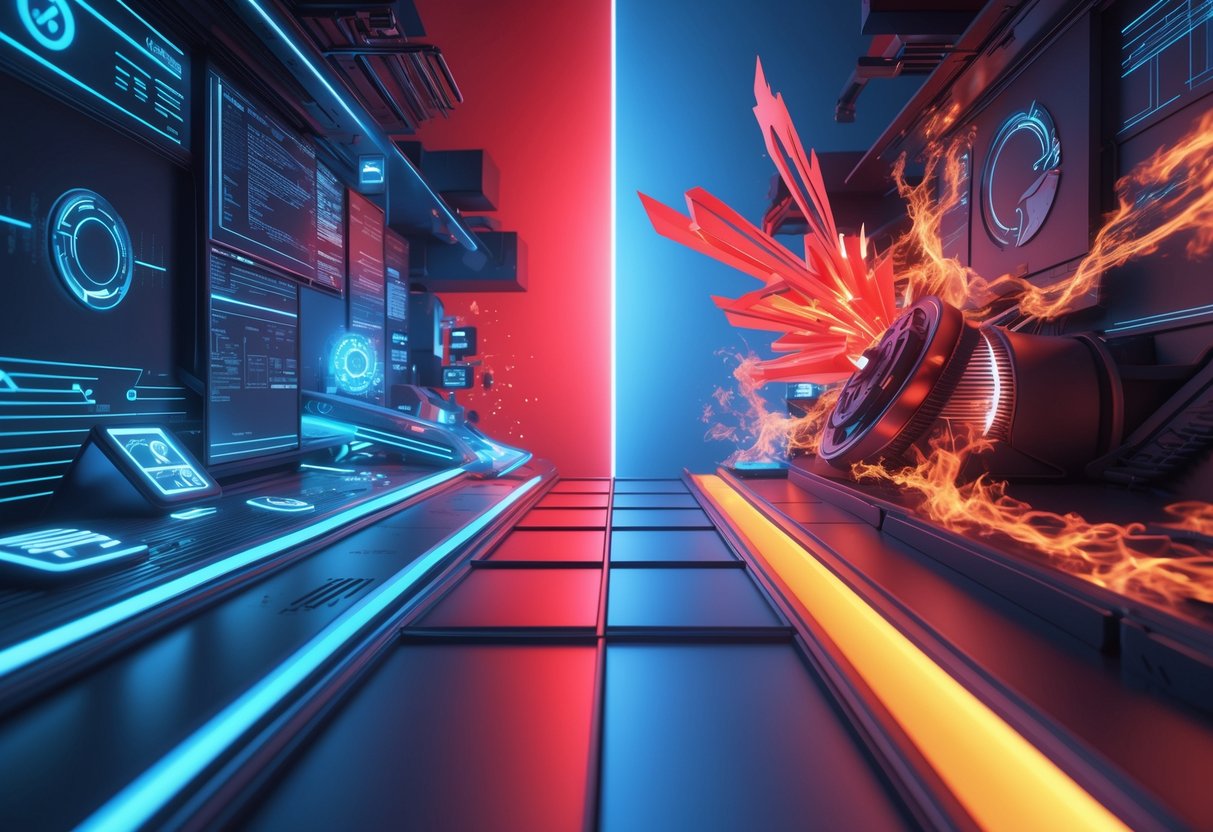
The two sides on the League map come with their own strategic perks. Draft order, map positioning, and champion selection all play a part from the first pick to late-game rotations.
Draft Order and Pick-Ban Sequence
Blue side always gets first pick in the draft. That means they can lock in the strongest champion or deny it from the other team.
Teams on blue side often use that pick for meta powerhouses or comfort champs. It’s a big edge.
Red side, though, gets the last pick. They see four enemy champions before making their final choice.
Here’s the trade-off:
- Blue side: Grabs priority champs early
- Red side: Reacts and adapts with more info
The draft usually goes:
- Blue picks one champ
- Red picks two
- Blue picks two
- Red picks one
Strategic Map Orientation
The camera angle actually helps blue side players. Most people find it easier to play moving from bottom-left to top-right.
Blue side starts in that bottom-left corner, making skill shots and vision a bit easier.
Red side has to adjust, moving from top-right to bottom-left. It’s a subtle difference, but it matters.
Map objectives also play out differently:
- Dragon pit is easier to access for red side
- Baron’s position changes team fight angles
- Jungle paths aren’t quite the same
Riot made some tweaks in 2024 to make the sides more symmetrical. They wanted to even out those old advantages.
Champion Selection Strategies
Blue side usually goes for flex picks early. These champs can fit multiple roles, which keeps opponents guessing.
Securing power picks is the name of the game for blue. They need to know what’s strong in the meta and grab it fast.
Red side leans into counterpicks and synergy. They see more of the enemy draft, so they can build a comp to counter what blue is doing.
Typical red side moves:
- Hold a strong laner for last pick
- Build around teamfight synergy
- Target blue side’s weakest matchups
Some teams have clear side preferences. Certain coaches love blue’s proactive style, while others like red’s flexibility.
The draft phase takes about 10-15 minutes. Both teams have to juggle short-term power and long-term plans the whole time.
Strategic Value of Side Selection in Draft Phase
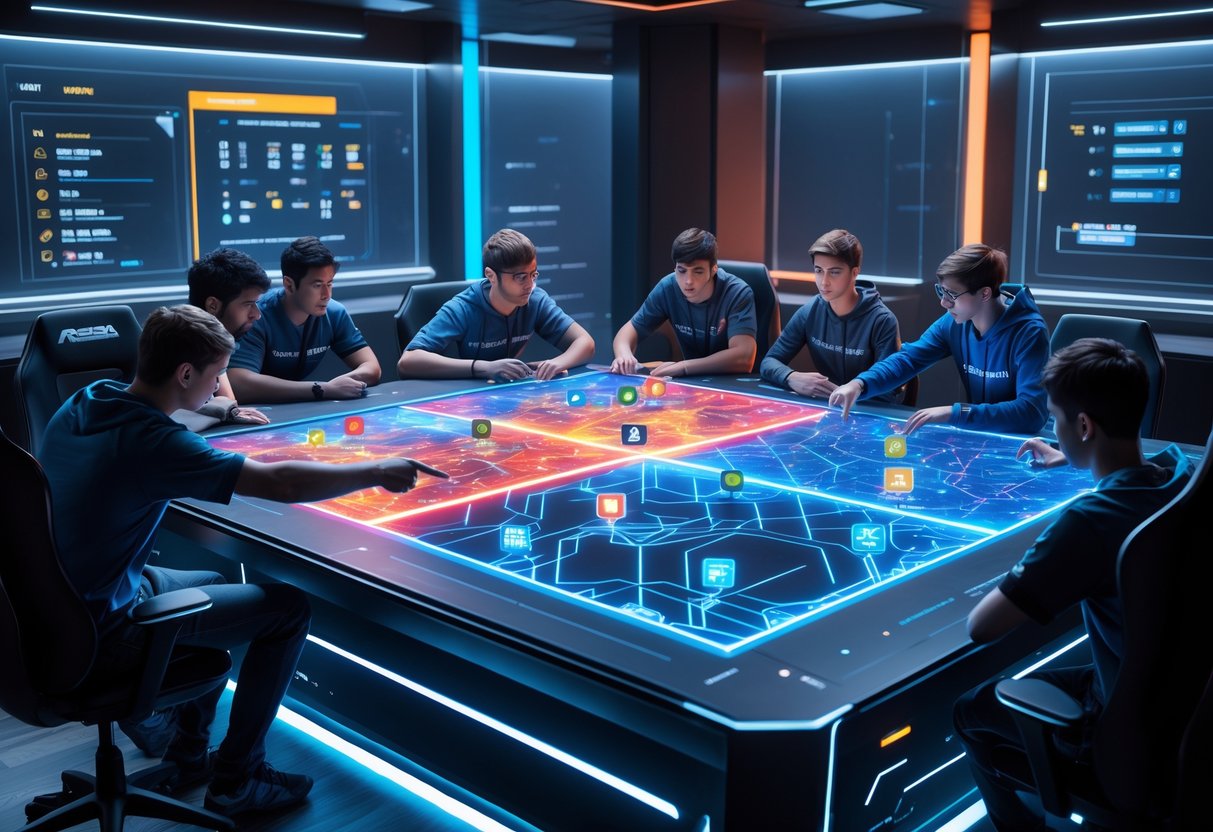
Side selection really shines during the draft phase. Blue side usually dominates the early draft with first pick, while red side can target specific lanes with their last pick.
First Pick Opportunities
Blue side enjoys the biggest draft advantage. They get to choose the strongest champion right off the bat.
If a champion is too strong, red side has to ban it or risk losing the game right there. At MSI 2022, Lucian was banned in 74 of 77 games—red side did it 63 times.
It’s a pattern. At Worlds S9, Pantheon was banned in 119 of 120 games, with red side banning him 116 times.
Blue side forces red to “waste” bans on meta champs, freeing up blue to ban more strategically.
When there are several OP champions, blue side can grab one and leave red scrambling to ban the rest.
Counterpick Advantages
Red side’s last pick is a big deal. They can wait, see what blue drafts, and then counter a key lane.
Teams often use this to target enemy carries or give their own stars a favorable matchup.
Red side also picks first after second-round bans, so they can remove counters or force blue into awkward spots.
Counterpicks matter most in solo lanes, especially top and mid. A good counter can shut down an enemy carry.
Pro teams do their homework. They know what the other team likes and prep red side counters to exploit it.
Priority Meta Champions
Who holds the draft advantage changes with the meta. If only a few champs are top-tier, blue side’s first pick is super valuable.
Teams often pick sides based on which priority champions they want. If there are three must-picks, blue side gets one, red side bans two.
Draft power shifts with every patch. Sometimes, red side’s flexibility is worth more than blue’s first pick.
Analysts track pick and win rates for each side throughout tournaments. It helps teams figure out what’s working right now.
Lately, the gap between sides has shrunk. Dragon buffs got stronger, which helps red side with their better pit access.
Map-Wide Strategic Implications
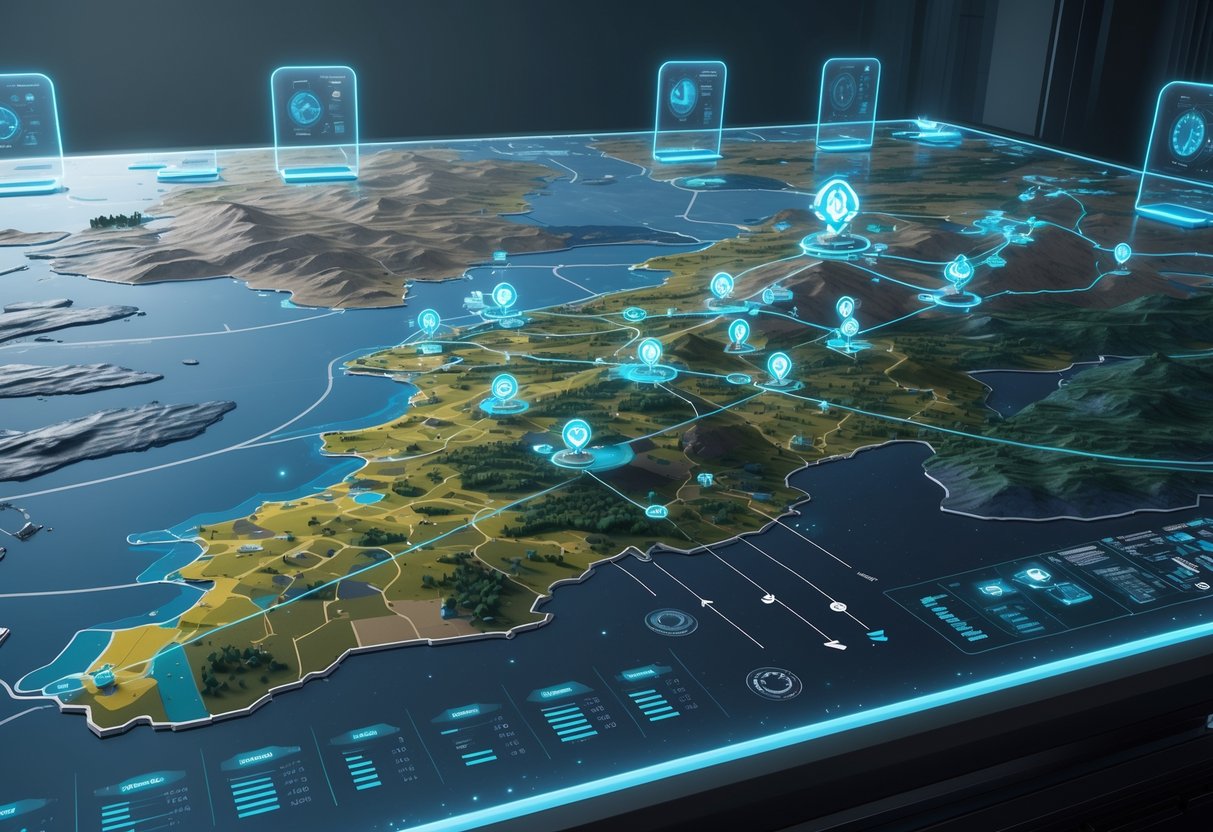
Choosing a side shapes jungle routes and exposes certain lane weaknesses. These macro considerations often decide which team hits their power spikes first and controls key objectives.
Jungle Pathing Differences
Blue side junglers usually start bot-side, getting a faster leash from their duo lane. This path leads straight to Dragon pit around five minutes in. They clear krugs, raptors, and then move right to early Dragons.
Red side junglers have tighter timings but better mid-game Baron access. Their bot-side start puts them in a weird spot for early Dragons but sets up great Baron plays later. Lots of red side junglers clear top-side to keep their options open.
Pathing efficiency isn’t the same for both sides. Blue side has easier rotations between the bottom jungle and Dragon. Red side often has to pick between fast clears and being in the right place for objectives.
Champion-specific routes make a big difference. Aggressive junglers like Lee Sin love blue side’s Dragon access. Scaling picks like Graves might favor red side for safer farming.
Lane Vulnerabilities and Pressure Points
Blue side bot lane sits right next to their own jungle entrance, so ganks get spotted more easily, but escaping is a bit safer. Still, the longer path back to safety gives red side more chances to punish if you overextend.
Red side mid lane feels constant pressure because blue side’s jungle sits so close. Pro teams love to camp red side’s mid early on. The short distance lets blue side junglers threaten ganks almost nonstop.
Top lane isolation hits each side differently. Red side’s top laner usually finds better escape routes into their own jungle. Blue side’s top has to rotate farther, but gets more creative teleport flanks when fighting around Dragon pit.
Vision control follows some almost predictable habits. Blue side tends to ward red side’s bottom jungle hard to keep their Dragon plays safe. Red side, meanwhile, dumps vision near Baron to take advantage of late-game fights.
Historical Impact of Side Selection on Competitive Outcomes

Side selection has really shaped some of League of Legends’ most important matches. Teams in top regions built unique strategies around first pick and counter-pick. The LPL and LCK, for example, have totally different priorities, and iconic finals often came down to smart draft choices tied to side selection.
LPL and LCK Case Studies
The LPL almost always grabs blue side when they can. Chinese teams love early aggression, and first pick lets them snag the strongest champs right away.
LPL teams use blue side to lock down jungle-mid duos early. They often pick up champs like Graves or Nidalee for jungle, then pair them with an assassin mid. This style fits their fast-paced games.
LCK teams flip the script. Korean squads often pick red side if they get the choice, valuing counter-pick for lanes like mid or ADC.
LCK’s methodical style fits red side drafts. Teams like T1 and Gen.G lean on their macro to come back from early deficits, drafting scaling lineups that really shine with targeted counter-picks.
From 2022 to 2024, LCK teams won 58% of their red side games. LPL teams only managed about a 52% win rate on red side in the same stretch.
Breakdown of Iconic Finals
The 2018 Worlds Final—Invictus Gaming vs. Fnatic—showed just how much side selection can matter. IG chose blue side in three out of four games, aiming for early jungle control.
In Game 1, IG grabbed Xin Zhao and LeBlanc with their first picks. That combo just ran over the early game, ending the match in only 19 minutes. Fnatic looked lost against the tempo.
Game 3 really highlighted side strategy. IG again took blue side and picked Camille jungle. Fnatic didn’t see it coming, and IG clinched the title.
The 2020 Worlds Final—DAMWON vs. Suning—played out differently. DAMWON picked red side for games 2 and 4, using counter-picks to shut down Suning’s carries.
Each draft phase felt like a chess match, with both teams using side selection to outmaneuver the other.
RNG’s Use of Side Selection
Royal Never Give Up probably ran one of the most flexible side selection approaches ever seen. They didn’t stick to one side; they adjusted based on their opponent’s strengths and weaknesses.
When facing teams with scary early games, RNG picked red side 70% of the time. They used counter-picks to hold off aggressive laners and play for late-game team fights, which synced perfectly with Uzi’s carry style.
During their 2018 MSI run, RNG mixed it up. Against Kingzone, they went blue for early picks; against Fnatic, they swapped to red for bot lane counter-picks.
Their adaptability gave them a real edge. RNG won 65% of matches where they got to choose their side during their best era (2017-2019).
The coaching staff prepped multiple draft plans for each side. That let them pivot mid-series if opponents started showing certain habits.
Side Selection in Major Esports Leagues
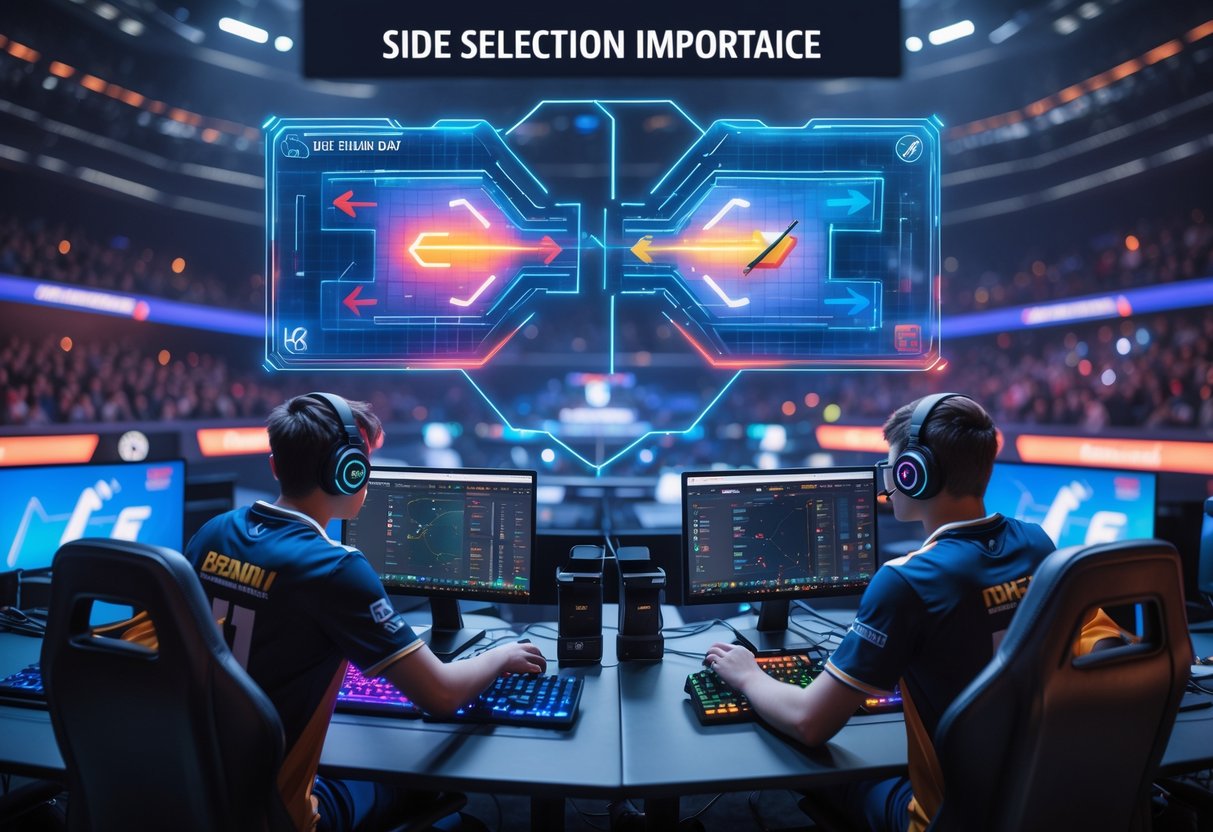
Leagues around the world handle side selection in their own ways. Some use seeding, others experiment with skill-based systems to spice things up.
LEC Side Selection Procedures
The LEC keeps it classic with seeding. In the regular season, teams just alternate sides in their two meetings.
For playoffs, higher seeds get first pick on side selection. That gives them a bit of an edge when it matters most.
Key LEC Side Selection Rules:
- Regular season: Teams swap sides each time
- Playoffs: Higher seed picks first
- Best-of-five: Sides alternate, higher seed starts
The LEC uses the same system as other major Western leagues. Teams know exactly what to expect and can prep their drafts accordingly.
Regional Approaches Across Leagues
The LPL has started using 1v1 showdowns for side selection in some matches. Players duel under set rules to win their team’s preferred side.
Both players ban three champs, then pick from what’s left—sometimes leading to mirror matchups.
The LCK sticks with traditional seeding. Higher-ranked teams always get side pick throughout playoffs and tournaments.
Regional Differences:
- LPL: Testing 1v1 duels for side selection
- LCK: Seeding priority
- PCS/VCS: 1v1s for games one or three
Some APAC regions, like PCS and VCS, have also tried the 1v1 format. Riot’s keeping an eye on these experiments before rolling them out everywhere.
Statistical Trends and Win Rates by Side

Blue side still has a small edge in pro League, but the gap’s shrinking, especially in best-of-series.
Historical Performance Data
Across about 5,000 pro matches since 2020, blue side wins 51.9% of the time. This covers LCK, LPL, LEC, and LCS.
Blue side does even better in the first game of a series—52.8% win rate for opening games, but only 50.9% in later games.
Match Type Win Rates:
| Match Position | Blue Side Win % | Sample Size |
|---|---|---|
| First Match | 52.8% | ~4,500 games |
| Match 2+ | 50.9% | ~500 games |
Teams seem to adjust after game one, so the side selection edge matters most before anyone’s adapted.
Yearly data shows blue side’s lead is fading. In 2022, red side actually won 52.0% of non-first matches in best-of-series.
Notable Anomalies and Exceptions
Game 5s flip the script. Red side wins 62.5% of deciding matches in best-of-fives.
But, honestly, that’s only about 50 games—so, not exactly a huge sample.
Regions show their own quirks too. LEC and LCS best-of-ones look different from LCK and LPL best-of-threes.
The 2022 MSI Finals brought this up—T1’s coach blamed their loss on not getting blue side three times. Still, the numbers suggest that advantage isn’t as big as it used to be.
Quick tip: Focus on draft prep, not side selection. That tiny 1-2% difference is nothing compared to better strategy and execution.
Recent Developments: AI and Analytics in Side Selection

AI tools now break down draft patterns and predict outcomes with surprising accuracy. Teams tap into massive data sets and player stats to make smarter picks.
Role of AI in Draft Optimisation
AI-powered draft tools have changed the game for pro teams. These systems look at thousands of matches to spot winning combos and sneaky counter-picks.
Machine learning algorithms crunch tons of data at once: champ win rates, player histories, team comps. They notice patterns that humans might miss, especially with the clock ticking during drafts.
Modern teams use AI to guess enemy picks in advance. The software checks opponent habits and spits out the best responses. Some tools now hit over 75% accuracy for predicting the next enemy pick.
Draft simulators let coaches practice different scenarios. They run through strategies against AI that mimics real teams. This kind of prep is huge for tournaments where every pick can decide the game.
The tech even spots power spikes and timing windows. Teams learn the exact moment their comp gets stronger than the enemy’s. That info shapes both drafts and in-game calls.
Predictive Analysis for Side Advantage
Analytics platforms now give teams exact win probability changes based on side and draft. Blue and red side edges swing hard depending on picks and strategy.
Stat models track how champs do on each side. Some champs win 8-10% more on blue, thanks to first pick. Others thrive on red with last-pick counters.
Teams get real-time win chance updates during draft. Each pick and ban tweaks the odds. Pro teams sometimes see 15-20% swings in predicted outcomes just from draft.
Map control algorithms break down warding and objective stats. Blue side usually gets early dragon control. Red side claims better Baron setups late.
Advanced tools now look at individual champ mastery. If a player wins 70% on a certain champ, that matters way more than any general stat. Personal data gives more accurate predictions than broad averages.
Influence of Side Selection on Team Fight Dynamics
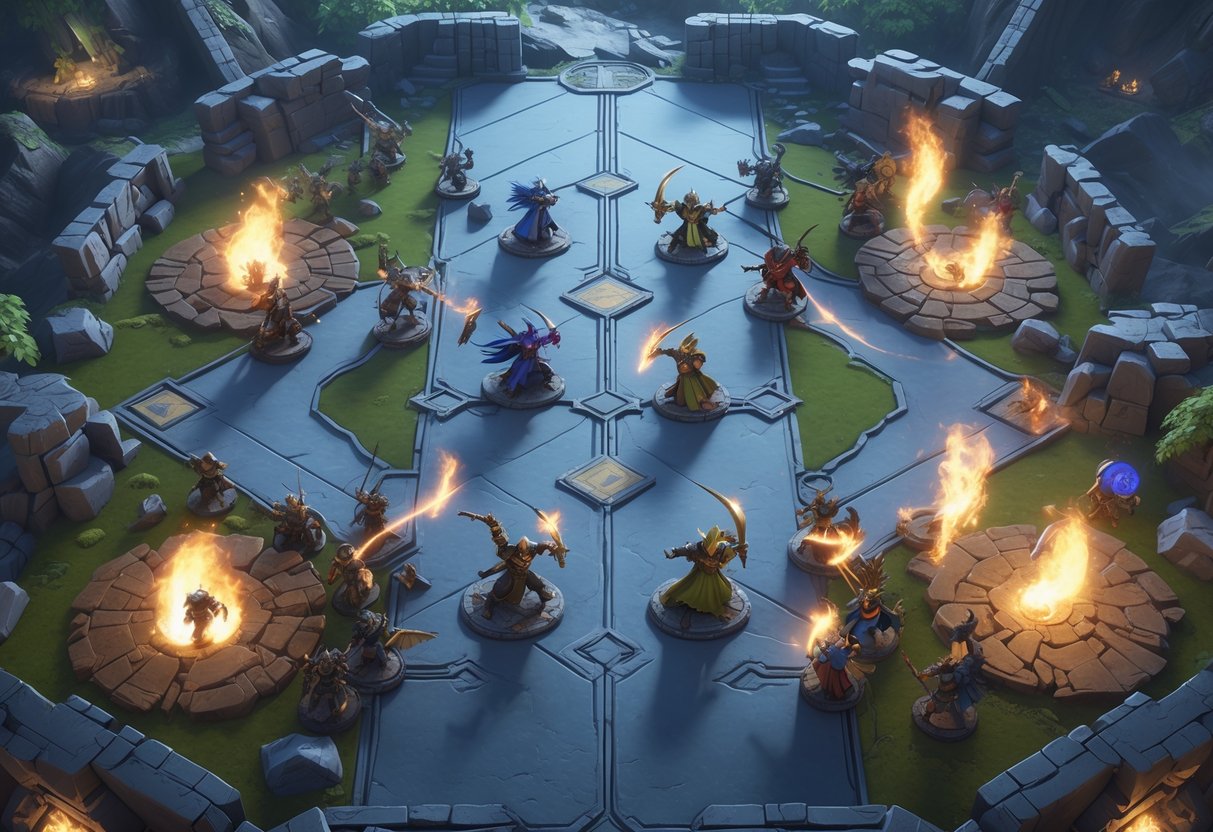
Blue and red sides create very different team fight setups through map and vision. Red side teams tend to rule dragon control, while blue side usually owns Baron fights.
Vision Control and Objective Plays
Blue side teams get easy vision around upper river. The map just lets them drop wards in baron pit and nearby jungle without much hassle.
This really comes into play during team fights near baron. Blue side can set up vision from several angles, using wide corridors to spread out.
Red side teams have a rougher time controlling baron vision. They’re forced through tight chokepoints and end up in more predictable spots.
But at dragon, it’s the opposite. Red side can cover the lower river with wards, taking over brush and escape routes.
During dragon fights, red side spreads out more, while blue side gets funneled into tighter spaces. That changes how both sides approach the fight.
Vision battles often decide who wins team fights. The team with better control around objectives usually comes out on top.
Approaches to Major Objectives
Team fight setups shift a lot depending on side. Blue side teams approach baron with confidence, since the terrain is on their side.
They can attack from river, jungle, or lane—forcing red side to watch several angles.
Red side teams adapt by looking for picks before baron fights. They deny vision and set up flanks, often dodging straight-up baron fights.
At dragon, red side takes the lead. They control the pit entrance and nearby jungle. Blue side sometimes struggles to escape if things go south.
Pro teams build team fight comps around these side strengths. Red side grabs champs with strong flanks. Blue side prefers front-to-back team fighting.
The numbers back this up. Teams win more fights near the objective that fits their side. That shapes both draft and late-game calls.
Adapting Strategies: Team and Coach Perspectives
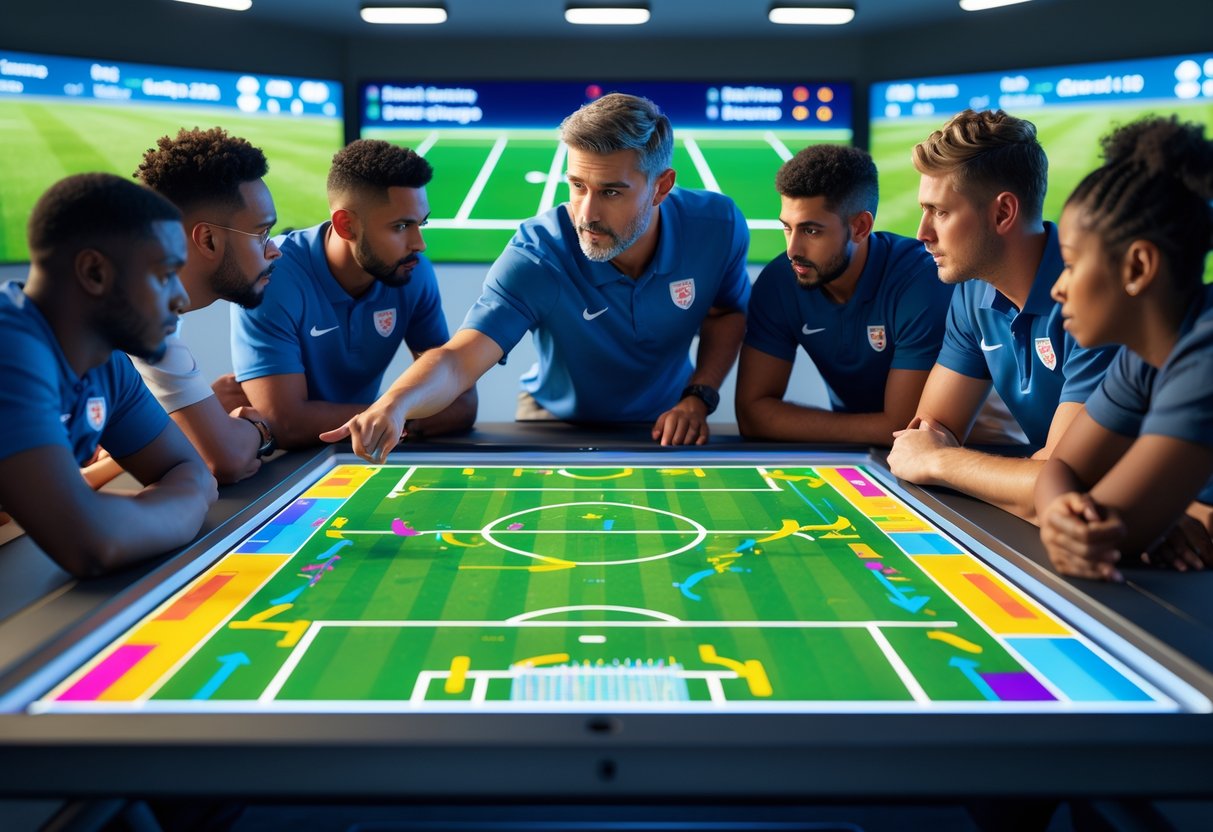
If you want to keep up in esports, you have to tweak your approach before and after every match. Teams that prepare well mix up their drafting strategies, and after matches, they dive into post-match analysis to spot what went wrong or right.
Draft Preparation and Flexibility
Draft prep means teams study a handful of strategies instead of just sticking to one. The top squads usually practice at least three different draft combos for each match.
Pre-match prep usually looks like this:
- Scouting each opponent’s champion pool
- Debating which bans matter most
- Picking backups in case bans get weird
- Assigning flexible roles
Most pro teams pour about 60-70% of their prep time into draft scenarios. This way, when someone bans out a comfort pick, players can pivot fast.
Quick win: Check out how G2 Esports shifts their drafts during LEC series—it’s pretty slick.
Coaches usually come in with a “Plan B” that flips the script on the team comp. Sometimes that means swapping from an aggressive early-game plan to a slow-burn, late-game scaling setup.
The best teams keep their players comfy on four or five champs per role. That makes it way harder for opponents to ban out a whole strategy.
Post-Match Adjustments
After a match, teams have just 10-15 minutes to spot problems and fix them before the next game. Coaches and analysts really have to move fast here.
Teams usually tweak things like:
- Vision control—shifting wards based on what the other team’s up to
- Objective focus—maybe dragons one game, towers the next
- Lane assignments—swapping roles or matchups on the fly
Good coaches don’t overload players. They focus on two or three changes that matter most. Sometimes, you’ll see a team completely flip their early-game plan if the first map goes badly.
Warning: If you try to change too much between games, players can get lost and play worse.
Data tools speed things up. Most pro orgs use software to track what the other team likes to do and suggest counters.
The best teams walk a line: they stay true to their strengths but always look for ways to exploit the other team’s weaknesses. Coaches and players have to keep talking during those short breaks.
The Future of Side Selection in Esports
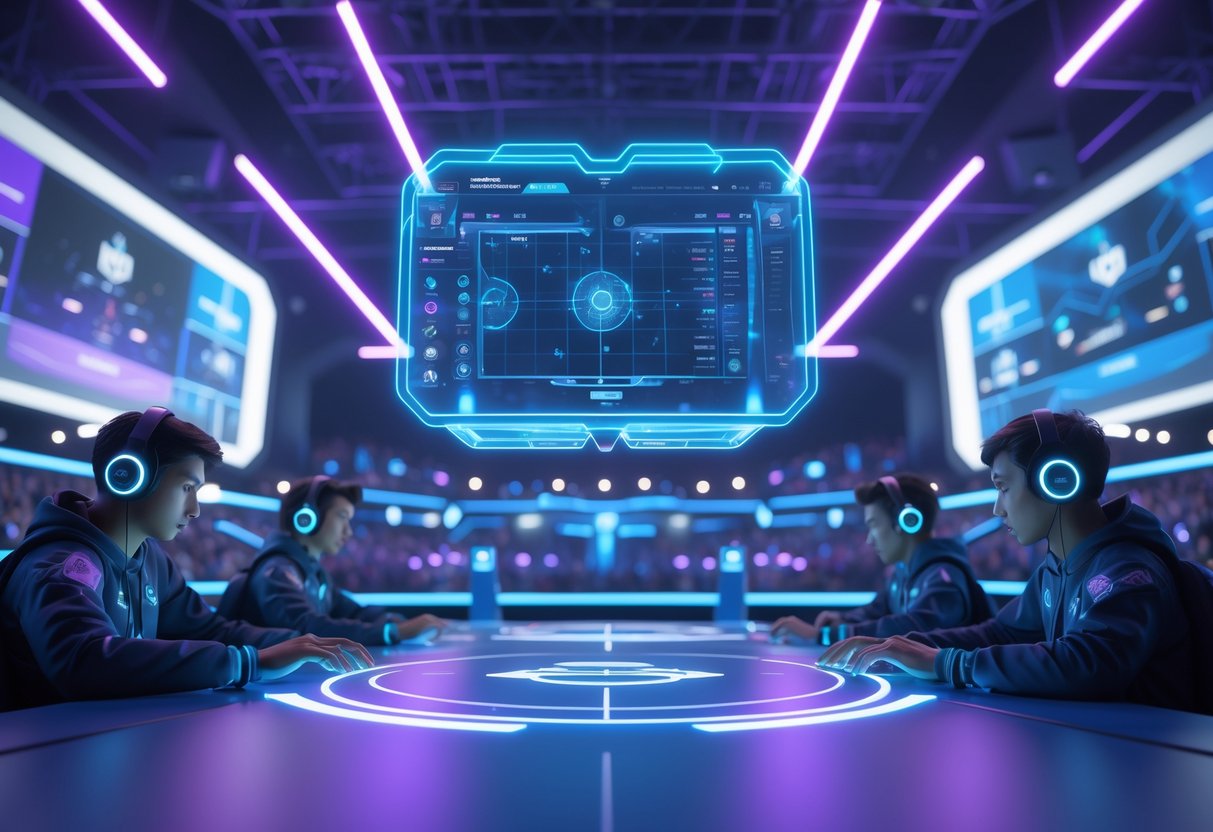
Esports orgs are experimenting with new ways to decide which team picks their starting side. Riot Games rolled out 1v1 showdowns in League of Legends APAC leagues, ditching the old coin flips and seeding picks.
Potential Rule Changes
The 1v1 Showdown, launched in 2024, really shakes things up compared to the old methods. Now, teams in the Pacific Championship Series and Vietnam Championship Series play mini-duels for the right to pick sides.
Current 1v1 Showdown Rules:
- First to 2 kills or destroy enemy turret wins
- 7-minute timer leads to sudden death
- Ring of Fire closes in during sudden death
- Mirror champs allowed after bans
This skill-based system could catch on in other games too. Lots of esports titles struggle with fair side selection, especially when map sides or draft orders give real advantages.
Right now, they’re testing regionally before going global. Riot says they won’t use 1v1 showdowns at international events—at least not yet. They’re watching how it affects competitive balance and whether fans even like it.
Some leagues are actually going back to coin flips for certain matches. Maybe the skill-based system isn’t perfect yet.
Balancing for Fair Play
Map design really changes how much side selection matters. Blue side gets first pick in champ select, while red side gets the last counter-pick. Depending on the meta or patch, these perks can swing a match.
Stats show red side often wins late-game objectives like Baron or Elder Dragon. But blue side usually has the edge early on because of draft position. Game devs keep tweaking maps, trying to even things out.
Potential Solutions Getting Tested:
- Rotating sides mid-series
- Giving extra picks to the weaker side
- Changing maps to balance things out
- Trying new draft formats
Tournament organizers have to juggle fairness and hype. The 1v1 showdown is fun to watch, but it might favor players with better mechanics over teams with smarter strategies.
Honestly, real solutions probably have to come from game design, not just new rules. We’ll likely see devs focus on map balance instead of adding more pre-game gimmicks.
Frequently Asked Questions
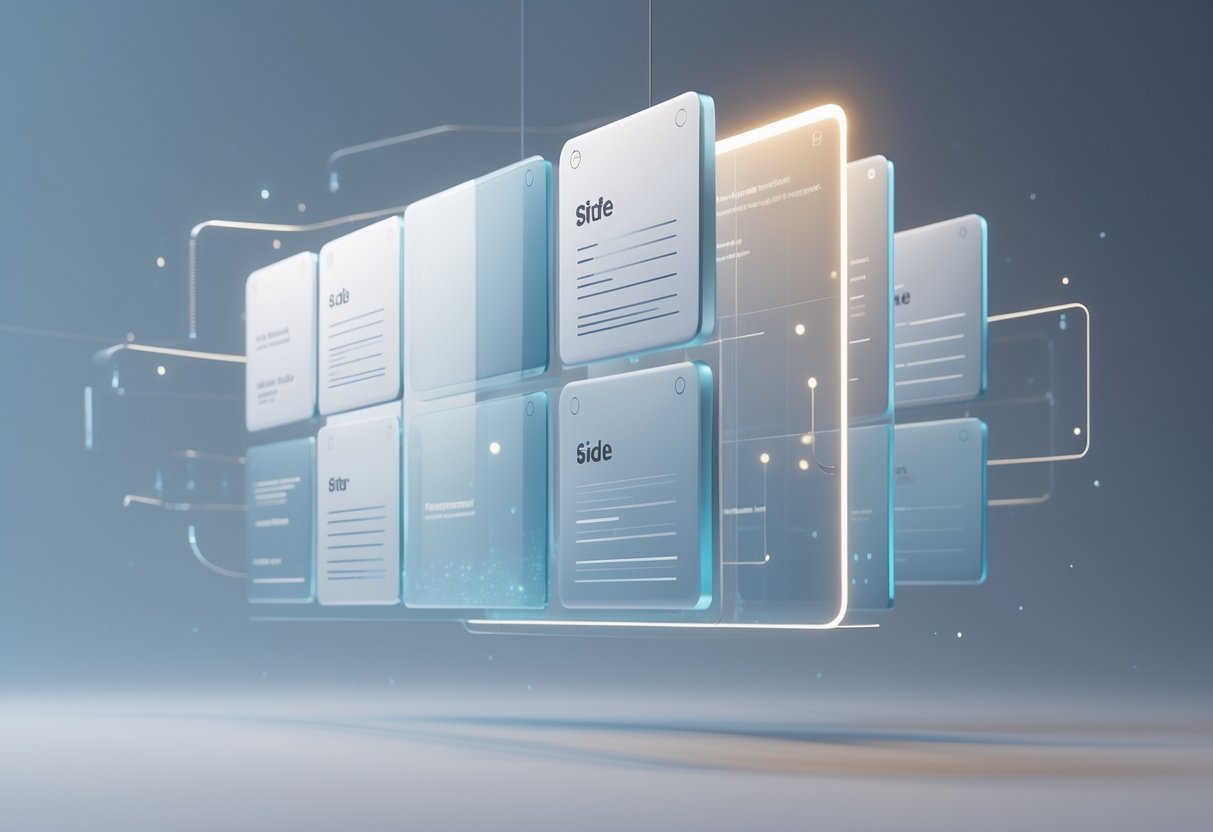
Side selection always stirs up debate among players, coaches, and fans. These questions show just how much things like map layout and starting position can shape a match.
Why is choosing the right side on the pitch vital for a team’s strategy?
Each side of an esports map gives teams different advantages. CT-side in CS2 is great for setting up defenses, while T-side is all about coordinated aggression and entry frags.
Pro teams spend hours breaking down spawn spots and angles. Red side in League of Legends makes grabbing dragons early easier. Blue side? It’s better for Baron fights late in the game.
Map layout creates choke points that favor one side or the other. Teams build their whole playbook around these strengths.
How does side selection affect a player’s performance in a match?
Players don’t all play the same on every side. AWPers in CS2 have a tougher time on certain sides because of sightline and rotation issues.
ADC players in League often want red side for safer jungle help during lane phase. Supports find it easier to ward from blue side, thanks to better river access.
Aim-based players tend to do better when they stick to angles they know. Map knowledge really matters—players have to adjust their aim and movement for each side.
In what ways can the direction of play influence the outcome of a game?
Sometimes, things like wind or lighting can still mess with players in certain games. Overwatch maps, for example, give different high ground options depending on where you spawn.
Starting positions change how fast teams can rotate or get to objectives. If you reach a key spot first, you control the pace—and that stacks up over rounds.
Win rates can swing by 5-15% depending on which side you start on. Analysts watch those numbers closely to plan drafts and vetoes.
Can the choice of ends impact a team’s defensive and attacking tactics?
Defensive setups depend a lot on what kind of map control and sight lines you get from spawn. In Counter-Strike, teams stack sites differently depending on their side.
Attackers have to consider entry points and timing. Some sides let you rush an objective way faster.
Teams usually practice separate tactics for each side. Smokes, flashes, rotates—they all change depending on where you start.
What factors should a captain consider when making a side selection at the toss?
Things like wind or server lag can give small but real advantages. The tournament format can also push teams to go for early momentum or save their best for late-game.
Knowing what the other team likes to do is huge. Some squads are comeback kings, others fall apart under pressure.
Captains should check recent match data and see where their players feel most comfortable. Sometimes, just feeling confident on a side gives a team a real psychological edge.
Does playing at home give a team an advantage when deciding which side to play from?
Home crowd energy hits players in different ways, especially depending on the map layout and where the audience sits. LAN tournaments usually wipe out most server-based advantages that local teams might have.
Teams get to run complicated strategies more smoothly when they practice in familiar environments. Players just seem to click better on setups they’ve used over and over at their home facility.
I’ve noticed that crowd noise messes with communication more on certain sides, thanks to how microphones pick things up. Teams really have to factor in these quirks when they prepare.

